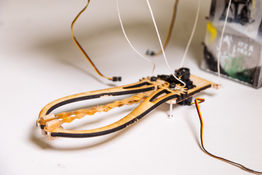TAXI-BOT PROJECT
Machine Engineering (Engs 76)
Arm & Claw Lead
SKILLS
Machine Engineering
SolidWorks Assembly & FEA
Design for Manufacturability
GD&T
CNC Mill & Lathe
Laser Cutter

CHALLENGE
Design a robot with material and energy constraints that can retrieve a toy figure from the ground and place it at a predetermined location above.

OVERVIEW
For my machine engineering class, four fellow students and I were tasked with creating a taxi-robot that retrieved a small figure from the bottom of the stand and brought it to the top platform. The primary design constraints were time, materials, and energy. We had less than 7 weeks to build a fully-functioning taxi-bot. We were also given a fixed list of materials that could be used and did not have the option using external materials. Lastly, 50% of the scoring criteria was based on energy consumption, so creating the most energy-efficient taxi-bot was an critical design constraint. We designed a unique pulley system that controlled the placement of the claw throughout the retrieval process. This project presented many hurdles; however, it was a rewarding experience to go through a very detailed design process and create a working product in the end while competing with my classmates.

MY CONTRIBUTIONS
Concept Generation
At the beginning of this project, each team member generated ideas for the taxi-bot and as a group we decided to consider two concepts. My concept of the pulley system wasn't initially well received. However, I used various rapid-prototyping techniques to create a mock-up as proof of concept. After the mock-up demonstration, we analyzed potential designs to understand the advantages and disadvantages of each respective design. In the end, my concept was chosen as our final design as we believed it would be the most energy and time efficient concept.

Arm Design
After finalizing our design, I was tasked with designing the arms that would extended over the platform and spooling system for the string and wire. I analyzed our arm using a FEA element analysis to confirm our arm is strong enough to withstand the forces throughout the retrieval process. I confirmed our arm has minimal deflection at during maximum loading.

Spool Design
I was also tasked with designing our spooling system in conjunction with one other group member. Spooling the wire proved much more difficult than anticipated. We initially began with a simple two wheel spooling system, but we moved to a three-wheel spooling system with guards to ensure twine and wire stay on their path during the spooling process. This three-wheel system proved to be a robust solution to our spooling issues.

Claw Design
Lastly, I was tasked with designing and developing our claw in conjunction with one other group member. We began with a 'L' shaped design but after FEA on SolidWorks we shifted towards a more curved designed to minimize stress concentrates in our design. Also, we removed unnecessary material inside the claw to minimize weight thus saving energy.

IMPACT & CONCLUSION
This project presented me many technical and design hurdles that stretch my capabilities as a mechanical design engineer. The material, time, and energy constraints created unique challenges that inspired me to create unique and effective solutions in a timely manner.




















